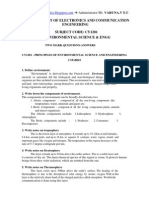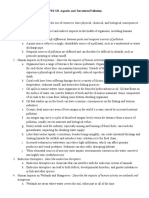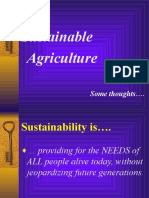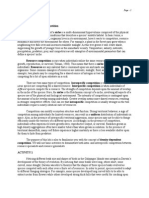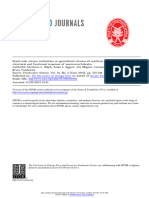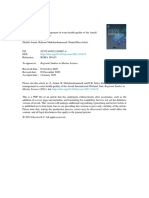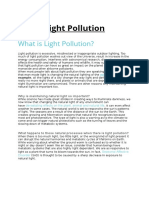Document
Document
Uploaded by
Aqsa khanCopyright:
Available Formats
Document
Document
Uploaded by
Aqsa khanOriginal Title
Copyright
Available Formats
Share this document
Did you find this document useful?
Is this content inappropriate?
Copyright:
Available Formats
Document
Document
Uploaded by
Aqsa khanCopyright:
Available Formats
Q1 Which of the following is the test to the the amount of organic matter present in soils.
a) Biological Oxygen Demand
b) Chemical Oxygen Demand
c) Botanical Oxygen Demand
d) Physical Oxygen Demand
Explanation: BOD measures the amount of oxygen consumed by microorganisms for
the process of decomposition of the organic matters in the water bodies.
It indicates the amount of organic pollution present in an aquatic ecosystem.
BOD is calculated in sewage treatment or wastewater treatment to find the destruction of
organic wastes by aerobic microbes
It determines the amount of organic matter present in soils, sewages, sediment, garbage,
sludge, etc.
The biochemical oxygen demand also determines the rate of respiration in living beings.
BOD is also used in the medicinal & pharmaceutical industries to test the oxygen
consumption of cell cultures
Q2. Which one of the following best describes the term xerarch succession.
(a) Succession that occure in wetter areas and the successional series progresses
(b) Succession that occurs on dry land where moisture content is low
(c) Succession that occure in biotic components of an ecosystem
(d) Succession that brought about by living inhabitants of that community itself
Explanation:
Statement 1 is incorrect:Hydrarch succession – When succession starts on the aquatic
habitat where water is plenty and progresses from hydric to mesic conditions or wetter conditions
Autogenic Succession: After biotic succession has begun, the existing vegetation is held responsible
for its own replacement by the new communities by changing the existing environmental condition.
This succession is known as autogenic succession.
Statement 2 is correct:Xerarch succession – When succession takes place in dry areas like a rock
(lithosere), sand (psammosere) and saline conditions (halosere).
Statement 3 is incorrect:Autogenic Succession: After biotic succession has begun, the
existing vegetation is held responsible for its own replacement by the new communities by changing
the existing environmental condition. This succession is known as autogenic succession.
Statement 4 is incorrect:
Q3.. Consider the following statement
1. Carbon monoxide
2. Methane
3. Volatile organic compound
4. Sulphur dioxide
Which of the above are released into the atmosphere due to the burning of
crop/biomass residue?
a) 1 and 2 only
(b) 3 and 4 only
(c) 2 and 3 only
(d) 1, 2, 3 and 4
Explanation:D
All the statement are correct:
Burning of crop residues is a common approach to eliminate
waste after harvesting all over the world. Burning of these
residues emit gases like sulphur dioxide (SO2), oxides of
nitrogen (NOx), carbon dioxide (CO2), carbon monoxide
(CO), black carbon (BC), organic carbon (OC), methane
(CH4), volatile organic compounds (VOC), non-methane
hydrocarbons (NMHCs), ozone (O3), and aerosols etc which
affect the global atmospheric chemistry and climate.
X factor:Crop residues / biomass burning not only influence
the atmospheric air quality including climate, it also affects
the human health
Q4.Consider the following statements with respect to Carbon Cycle
1. Carbon from the atmosphere is taken up by the green plants by
photosynthesis and then to animals by the food chain
2. Most carbon on earth is stored in rocks and sediments, while the rest
is located in the ocean.
Which of the statements given above is/are correct?
(a) 1 only
(b) 2 only
(c) Both 1 and 2
(d) Neither 1 nor 2
Explanation:A
Statement 1 is correct: Carbon from the atmosphere is taken up
by the green plants by photosynthesis and then to animals by
the food chain.
By respiration and decomposition of dead organic matter, it
returns to the atmosphere.
It is a short-term cycle.
Some carbon also enters a long term cycle
Statement 2 is incorrect:Most carbon on earth is stored in rocks
and sediments, while the rest is located in the ocean,
atmosphere, and living organisms. These are the reservoirs, or
sinks, through which the carbon cycles.
Q5.Consider the following differences between in situ and ex
situ conservation
1. In situ conservation is an on-site conservation and ex situ
conservation is an off-site conservation.
2. In situ involve man-made habitats whereas ex situ involve natural
habitats.
3. In situ Can be done for Wildlife and livestock conservation and ex
situ Can be done to conserve crops and their wild relatives.
Which of the statements given above is/are correct?
(a) 1 only
(b) 2 and 3 only
(c) 1 and 3 only
(d) 1, 2 and 3 only
Explanation:C
In-situ Conservation Ex-Situ Conservation
This is an on-site This is an off-site
conservation. conservation.
It involves the natural It involves the man-
habitats of organisms made habitats.
It is appropriate for It is appropriate for
animals found animals which are not
abundantly. found abundantly.
It is not suitable in It is the best option in
case of rapid decline in case of rapid decline in
the number of a the number of a
species, due to any species, due to any
factor. factor.
Can be done for Can be done to
Wildlife and livestock conserve crops and
conservation. their wild relatives.
Q6.The Global Coalition for Biodiversity is an initiative of
(a) The European Commission
(b) United Nations Environment Programme
(c) The International Union for Conservation of nature
(d) G20 countries
Explanation: The European Commission (EC) launched 'The Global coalition for
biodiversity' on World Wildlife Day 2020. The Coalition is made up of zoos,
aquariums, botanical gardens, national parks, and natural history and science
museums from around the world.
The coalition provides the opportunity to national parks, aquariums, botanic gardens,
zoos, science and natural history museums to raise public awareness about the
dramatic effects of the biodiversity crisis with their collections, education and
conservation programmes,
The Commission also encourages national, regional and local authorities, non-
governmental organisations, businesses, scientists and individual citizens to play
their part in raising awareness ahead of the United Nations Biodiversity Summit
You might also like
- Environment x class newDocument4 pagesEnvironment x class newkkharshu218No ratings yet
- CH 14Document26 pagesCH 14Lovely King PramothNo ratings yet
- Book Environment EcologyDocument44 pagesBook Environment EcologySanjana MishraNo ratings yet
- Pillar 2 BiodiversityecosystemDocument49 pagesPillar 2 Biodiversityecosystemsam paulNo ratings yet
- The Role Humans in Maintaining The Balance of NatureDocument4 pagesThe Role Humans in Maintaining The Balance of Naturepclim20100% (1)
- environment assignment -2Document11 pagesenvironment assignment -2aamir khanNo ratings yet
- Our Environment Q & AnsDocument4 pagesOur Environment Q & Anshlohlo032004No ratings yet
- Biology Grade 10 (Weeks 1-5) - Term 3Document86 pagesBiology Grade 10 (Weeks 1-5) - Term 3Daniel DowdingNo ratings yet
- Ecosystem: Multiple Choice Questions Multiple Choice Questions Single Correct Answer Type Single Correct Answer TypeDocument12 pagesEcosystem: Multiple Choice Questions Multiple Choice Questions Single Correct Answer Type Single Correct Answer TypeMehmood AnsariNo ratings yet
- Our Environment QuestionsDocument4 pagesOur Environment Questionsjasu383No ratings yet
- ENE 1 - Introduction to Environment and EcologyDocument51 pagesENE 1 - Introduction to Environment and EcologyVamsiKrishnaYadavNo ratings yet
- OUR ENVIRONMENT -Set A AnsDocument4 pagesOUR ENVIRONMENT -Set A Ansnidishrreddy31No ratings yet
- Biomagnification in Marine EcosystemsDocument29 pagesBiomagnification in Marine EcosystemsAngela Hansen100% (1)
- Med EasyDocument6 pagesMed Easyjanvipuri2008No ratings yet
- 13our EnvironmentDocument3 pages13our Environmentnamitarmehta15No ratings yet
- Untitled Document-2Document5 pagesUntitled Document-2mahinsagotra18No ratings yet
- Chapter 3 Summary (Introduction To Computing)Document9 pagesChapter 3 Summary (Introduction To Computing)Casey SaguingNo ratings yet
- 3676 Assignment 1Document31 pages3676 Assignment 1adeel raziNo ratings yet
- Lesson 1 - EcologyDocument304 pagesLesson 1 - EcologyJennalyn CasteloNo ratings yet
- E.S FinalsDocument17 pagesE.S FinalsPLATON GLADYS B.No ratings yet
- Our EnvironmentDocument6 pagesOur Environmentrishabhgarg24205No ratings yet
- Ecosystem MCQ 2-3Document10 pagesEcosystem MCQ 2-3Jyothi WNo ratings yet
- Mcqs Environment, Ecology and Biodiversity by Reva Mam 1Document40 pagesMcqs Environment, Ecology and Biodiversity by Reva Mam 1Altaf beighNo ratings yet
- Our Environ MentDocument7 pagesOur Environ MentMian TanveerNo ratings yet
- Evs Questions BankDocument12 pagesEvs Questions Bankmandalsiza74No ratings yet
- GE 32 Environmental ScienceDocument36 pagesGE 32 Environmental ScienceAnonymous 8pCXXsNo ratings yet
- Environmental Science and Engineering Ce 071Document24 pagesEnvironmental Science and Engineering Ce 071ainugiri100% (1)
- Chapter 14 EcosystemDocument6 pagesChapter 14 Ecosystemlavishbhati691No ratings yet
- Environmental Sustainability Course Code-Chy1006 (LT, 2 Credits) Unit-Ii Ecosystem and BiodiversityDocument26 pagesEnvironmental Sustainability Course Code-Chy1006 (LT, 2 Credits) Unit-Ii Ecosystem and BiodiversityCrackshot 69No ratings yet
- Evs Question and AnswersDocument17 pagesEvs Question and AnswersSuganya MNo ratings yet
- Mev 11 Assignment 2022 23Document16 pagesMev 11 Assignment 2022 23sillent cillerNo ratings yet
- Evs 2 Mark Question and AnswersDocument36 pagesEvs 2 Mark Question and Answershariharanbook100% (5)
- BCE 4106 Notes1Document13 pagesBCE 4106 Notes1Fred MukisaNo ratings yet
- Chapter 7 BIODIVERSITY & ENVIRONMENTAL PROBLEMSDocument7 pagesChapter 7 BIODIVERSITY & ENVIRONMENTAL PROBLEMSMohamed Ali AhmedNo ratings yet
- Lec 5-6 IUB_nutrient cyclingDocument36 pagesLec 5-6 IUB_nutrient cyclingskekegenkaiNo ratings yet
- Ecosystem Thermodynamic System Ecosystem SystemDocument5 pagesEcosystem Thermodynamic System Ecosystem SystemArcely Dela Cruz ArmonidadNo ratings yet
- Iiyear Electronics and Instrumentation Engineering GE32-Environmental Science and EngineeringDocument36 pagesIiyear Electronics and Instrumentation Engineering GE32-Environmental Science and EngineeringsrajeceNo ratings yet
- Melc 7 (Last Topic For Eals)Document4 pagesMelc 7 (Last Topic For Eals)Jherome CastuloNo ratings yet
- D.1. Generation and Maturation Processes: Formation and Preservation of Organic MatterDocument37 pagesD.1. Generation and Maturation Processes: Formation and Preservation of Organic MatterDedy DayatNo ratings yet
- EEDM 2024 Full NotesDocument69 pagesEEDM 2024 Full Notesmanmithrane149No ratings yet
- Department of Electronics and Communication Engineering Subject Code: Cy1201 Environmental Science & EnggDocument20 pagesDepartment of Electronics and Communication Engineering Subject Code: Cy1201 Environmental Science & EnggJohn BerkmansNo ratings yet
- Apes U8 Aquatic and Terrestrial PollutionDocument4 pagesApes U8 Aquatic and Terrestrial Pollutionapi-352694884No ratings yet
- Chapter 55 Practice Multiple ChoiceDocument7 pagesChapter 55 Practice Multiple Choiceyearap25No ratings yet
- Biology Grade 10thDocument13 pagesBiology Grade 10thXavier MehrezNo ratings yet
- (II) Ecology-UnlockedDocument96 pages(II) Ecology-UnlockedMANAS GOELNo ratings yet
- ScienceDocument13 pagesSciencejevanhope.baltazarNo ratings yet
- 12 Biology Revision Questions 2017 18 Chapter 14Document10 pages12 Biology Revision Questions 2017 18 Chapter 14AbhiNo ratings yet
- Our Environment NotesDocument7 pagesOur Environment Notesckcoaching SiliguriNo ratings yet
- GE6351 Environmental Science and EngineeringDocument261 pagesGE6351 Environmental Science and EngineeringAkshay UdayNo ratings yet
- Evs Question and AnswersDocument17 pagesEvs Question and AnswersSolairajaNo ratings yet
- EVS solved question paperDocument3 pagesEVS solved question papersurekhchaudhari97No ratings yet
- 9_Natural_ecosystems_and_human_activitiesDocument16 pages9_Natural_ecosystems_and_human_activitieslogienmekkiNo ratings yet
- Geography Chapter 1Document4 pagesGeography Chapter 1t6003228984No ratings yet
- MLP - Chap 1 - Environment 2024Document3 pagesMLP - Chap 1 - Environment 2024competest6No ratings yet
- Environmental Studies notes(1)Document41 pagesEnvironmental Studies notes(1)Sriya SriNo ratings yet
- Sample Mcqs (Part 1) On Environmental ManagementDocument30 pagesSample Mcqs (Part 1) On Environmental ManagementKrishna GolarNo ratings yet
- Q4 Hashir BhaiDocument4 pagesQ4 Hashir BhaiMuhammad Hashir AzizNo ratings yet
- Types, Energy Flow, Nutrient Cycling, ProductivityDocument16 pagesTypes, Energy Flow, Nutrient Cycling, Productivityministore kmcNo ratings yet
- GGY 301 Lesson 6Document7 pagesGGY 301 Lesson 6mukaibridget1No ratings yet
- How Would You Reconcile The Emerging Needs and BiodiversityDocument7 pagesHow Would You Reconcile The Emerging Needs and BiodiversityLianna Rodriguez100% (6)
- Agroforestry-Principles DesignDocument12 pagesAgroforestry-Principles Designtjahjo trihartonoNo ratings yet
- A2 Deldin La GuadeloupeDocument18 pagesA2 Deldin La Guadeloupeapi-344122258No ratings yet
- Geography June 2024 Grade 12 Memo ..Final .6.06Document10 pagesGeography June 2024 Grade 12 Memo ..Final .6.06malebomokwena07No ratings yet
- Sustainable AgricultureDocument98 pagesSustainable AgricultureBrijraj PandeyNo ratings yet
- Russ Jones Environmental Landscaping: Consulting ! Designing ! MaintainingDocument1 pageRuss Jones Environmental Landscaping: Consulting ! Designing ! MaintainingRuss JonesNo ratings yet
- 12.environmental Research and OrganisationsDocument56 pages12.environmental Research and OrganisationsSyed Faiaz Hossain 1330644030No ratings yet
- ScriptDocument3 pagesScriptIrina HornoiuNo ratings yet
- Intra and Interspecific CompetitionDocument4 pagesIntra and Interspecific CompetitionheyyyaleNo ratings yet
- Iznenadi Me Sophie KinsellaDocument8 pagesIznenadi Me Sophie KinsellaDijete SuncaNo ratings yet
- INTERNSHIP(ppt(.pptxDocument11 pagesINTERNSHIP(ppt(.pptxajaysudevan31No ratings yet
- Dolph Et Al 2015Document13 pagesDolph Et Al 2015Kiosko San JoséNo ratings yet
- Role of Participatory Management in Water Health Quality of The Anzali International Wetland IranDocument21 pagesRole of Participatory Management in Water Health Quality of The Anzali International Wetland IrannhungNo ratings yet
- What Is Light Pollution?Document4 pagesWhat Is Light Pollution?Redeemer ReeveNo ratings yet
- Reflection Paper 1 - Lion KingDocument2 pagesReflection Paper 1 - Lion KingEsclet PHNo ratings yet
- Land Use Report - Envl 4300 - Christopher GundersonDocument25 pagesLand Use Report - Envl 4300 - Christopher Gundersonapi-723401842No ratings yet
- Distribution of WaterDocument20 pagesDistribution of WaterVan IllaNo ratings yet
- Galle City Lowcarbon PresentationDocument23 pagesGalle City Lowcarbon PresentationPradeep EhanNo ratings yet
- PGD-PPT-II - Environmetal Science and Plastics Waste ManagementDocument2 pagesPGD-PPT-II - Environmetal Science and Plastics Waste ManagementRaj ThakurNo ratings yet
- Alex O. Awiti BioDocument1 pageAlex O. Awiti BioAlex AwitiNo ratings yet
- 436 637 2 PBDocument14 pages436 637 2 PBnisakNo ratings yet
- Types of Environmental ImpactDocument8 pagesTypes of Environmental ImpactLedith LedithNo ratings yet
- WOA II - United Nations Ocean Vol IIDocument520 pagesWOA II - United Nations Ocean Vol IIDiego TrindadeNo ratings yet
- TTS Multiple ChoiceDocument8 pagesTTS Multiple ChoiceJueren MaciaNo ratings yet
- Official Gazette No 38 of 23.09.2013Document72 pagesOfficial Gazette No 38 of 23.09.2013habthNo ratings yet
- MST 112 PresentationDocument35 pagesMST 112 PresentationJay Bianca Abera AlistadoNo ratings yet
- Raunkiers Life FormsDocument11 pagesRaunkiers Life FormsEunice SantiagoNo ratings yet
- Narrative Report Tree PlantingDocument3 pagesNarrative Report Tree PlantingMamaanun PSNo ratings yet
- Sustainability Explained Through AnimationDocument4 pagesSustainability Explained Through AnimationNeals QuennevilleNo ratings yet








































